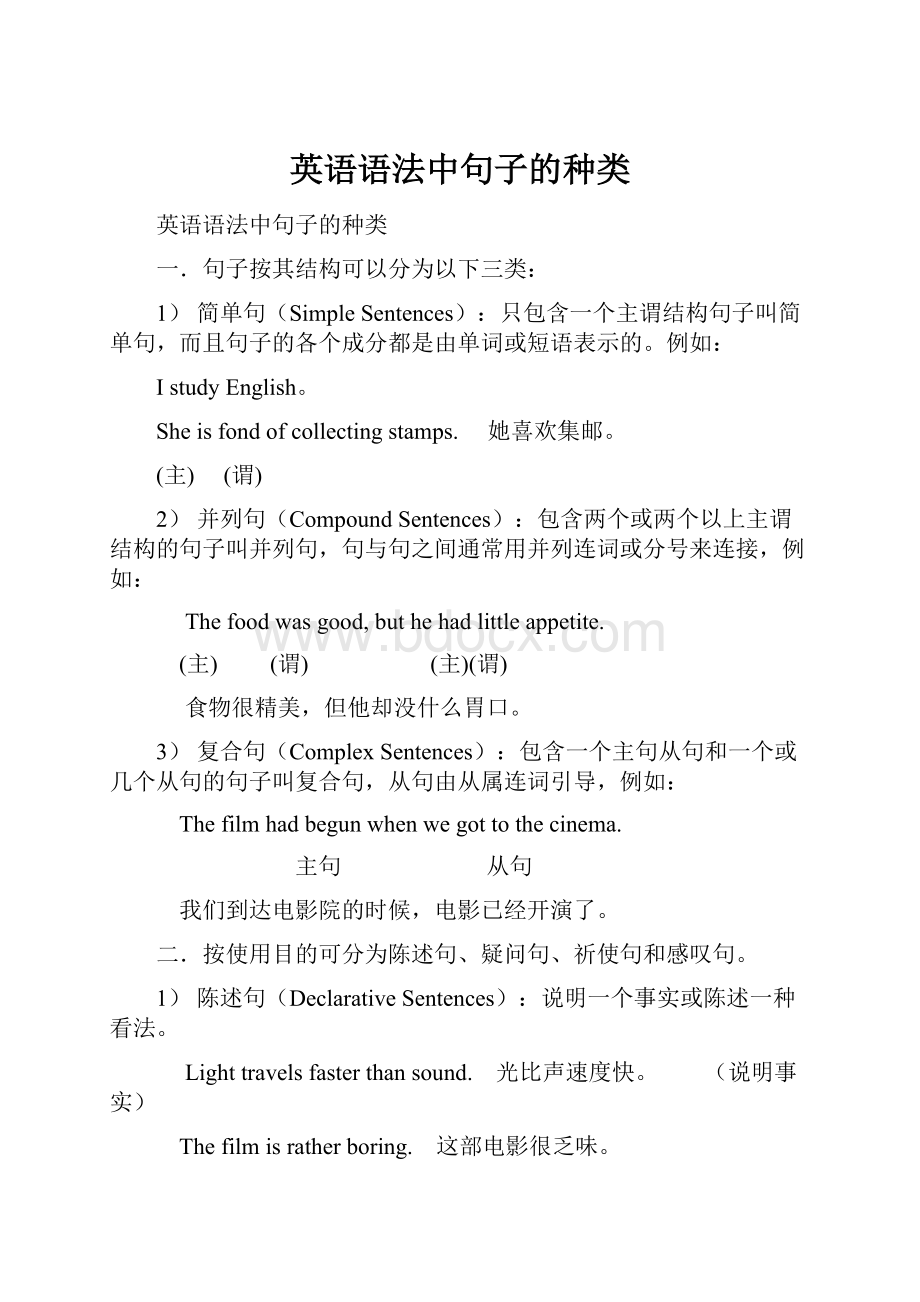英语语法中句子的种类.docx
《英语语法中句子的种类.docx》由会员分享,可在线阅读,更多相关《英语语法中句子的种类.docx(12页珍藏版)》请在冰豆网上搜索。

英语语法中句子的种类
英语语法中句子的种类
一.句子按其结构可以分为以下三类:
1)简单句(SimpleSentences):
只包含一个主谓结构句子叫简单句,而且句子的各个成分都是由单词或短语表示的。
例如:
IstudyEnglish。
Sheisfondofcollectingstamps. 她喜欢集邮。
(主) (谓)
2)并列句(CompoundSentences):
包含两个或两个以上主谓结构的句子叫并列句,句与句之间通常用并列连词或分号来连接,例如:
Thefoodwasgood,buthehadlittleappetite.
(主) (谓) (主)(谓)
食物很精美,但他却没什么胃口。
3)复合句(ComplexSentences):
包含一个主句从句和一个或几个从句的句子叫复合句,从句由从属连词引导,例如:
Thefilmhadbegunwhenwegottothecinema.
主句 从句
我们到达电影院的时候,电影已经开演了。
二.按使用目的可分为陈述句、疑问句、祈使句和感叹句。
1)陈述句(DeclarativeSentences):
说明一个事实或陈述一种看法。
Lighttravelsfasterthansound. 光比声速度快。
(说明事实)
Thefilmisratherboring. 这部电影很乏味。
(说明看法)
2)疑问句(InterrogativeSentences):
提出问题。
有以下四种:
a. 一般疑问句(GeneralQuestions):
Canyoufinishtheworkintime?
你能按时完成工作吗?
b. 特殊疑问句(WQuestions;HQuestions):
Wheredoyoulive?
你住那儿?
Howdoyouknowthat?
你怎么知道那件事?
c. 选择疑问句(AlternativeQuestions):
Doyouwantteaorcoffee?
你是要茶还是要咖啡?
d. 反意疑问句(Tag-Questions):
Hedoesn'tknowher,doeshe?
他不认识她,对不对?
3)祈使句(ImperativeSentences):
提出请求,建议或发出命令,例如:
Sitdown,please. 请坐。
Don'tbenervous!
别紧张!
4)感叹句(ExclamatorySentences):
表示说话人惊奇、喜悦、愤怒等情绪,例如:
Whatgoodnewsitis!
多好的消息啊!
三.基本句型(BasicSentencePatterns):
英语中千变万化的句子归根结底都是由以下五种基本句型组合、扩展、变化而来的:
1)主+动(SV)例如:
Iwork. 我工作。
2)主+动+表(SVP)例如:
Johnisbusy. 约翰忙。
常见的系动词三种;
A.表示视觉感觉:
seem,appear,look,taste,smell,sound,feel.
B.表示变化过程:
become,get,grow,turn,go,fall
C.表示保持目种状态:
be,stay,remain.keepcontinue,stand,sit
3)主+动+宾(SVO)例如:
ShestudiesEnglish. 她学英语。
4)主+动+宾+补(SVOC)例如:
Timewouldprovemeright.时间会证明我是对的。
动词不定式作宾语补足语应注意下列情况:
a.ask.tell.invite.force.get.beg.allow.want.likehate.prefer.intend.encourage.advise.persude.permit.remind.request,order.commandwarncause(to)
b.使役动词have,make,let(不带to)
c.see,watch,notice,hear,feel,observe等感官动词
5)主+动+间宾+直宾(SVOiOd)例如:
Mymothermademeanewdress. 我母亲给我做了一件新衣裳。
a.下列动词后带有间接宾语时,其前往往加介词“to”表方向:
giveshowsendbringpasslendhandtellreturnwritepaythrowteachpromiseowedeny
b2.下列动词后带有间接宾语时,其前往往加介词“for”表目的:
makebuydofetchgetpaintplaysavespareorderlooksingfindserve
13.1祈使句结构
祈使句用以表达命令,要求,请求,劝告等。
1)祈使句有两种类型,一种是以动词原形开头,在动词原形之前加do(但只限于省略第二人称主语的句子)。
Takethisseat.
Dobecareful.
否定结构:
Don'tmove.
Don'tbelate.
2)第二种祈使句以let开头。
Let的反意疑问句
a.Let's包括说话者
Let'shaveanothertry,shallwe/shan'twe?
=Shallwehaveanothertry?
b. Letus不包括说话者
Letushaveanothertry,willyou/won'tyou?
=Willyoupleaseletushaveanothertry?
否定结构:
Let'snottalkofthatmatter.
Letusnottalkofthatmatter.
13.2感叹句结构
感叹句通常有what,how引导,表示赞美、惊叹、喜悦、等感情。
what修饰名词,how修饰形容词,副词或动词,感叹句结构主要有以下几种:
掌握它的搭配,即掌握了感叹句的重点。
How+形容词+a+名词+ 陈述语序
How+形容词或副词+ 陈述语序
What+名词+ 陈述语序
What+a+形容词+名词+ 陈述语序
What+形容词+复数名词+ 陈述语序
What+形容词+不可数名词+ 陈述语序
Howcleveraboyheis!
Howlovelythebabyis!
Whatnoisetheyaremaking!
Whatacleverboyheis!
Whatwonderfulideas(wehave)!
Whatcoldweatheritis!
感叹句的省略形式为:
Whatacleverboy(heis)!
典型例题
1)___foodyou'vecooked!
A.Howanice B.Whatanice C.Hownice D.Whatnice
答案D.由于How修饰形容词,副词;what修饰名词。
且food为不可数名词,因此A,B排除。
CHow+adj.后面不能再加名词,因此只有D正确,其句型为What+adj.+n.(不可数)
2)___terribleweatherwe'vebeenhavingthesedays!
A.What B.Whata C.How D.Howa
答案A.weather为不可数名词,B,D排除。
C为how+adj.后面不应有名词。
只有A,符合句型What+形容词+不可数名词。
3)---_____Ihad!
---Youreallysufferedalot.
A.Whatatime B.Whattime C.Howatime D.howtime
答案A. 感叹句分两类:
1:
What+n.+主谓部分
2:
How+adj./adv./v.+主谓部分。
本题属第一种,但省略了bad,相对于WhatabadtimeIhad!
这是个习惯用语。
13.3强调句结构
常考的强调句结构是it引导的句子。
Itis(was)被强调部分+that(who)+句子其他部分。
此结构强调的成分仅限于主语,宾语和状语。
Itisfromthesunthatwegetlightandheat.
ItwasnotuntilIhadreadyourletterthatIunderstoodthetruestateofaffairs.
典型例题
1)Itwaslastnight___Iseethecomet.
A. thetime B. when C. that D. which
答案C.强调句的结构是:
It+be+强调部分+that(who)+主谓句。
强调句的连词只有两个,that和who。
当强调的部分是人,且为句子的主语时,才用"who",其余用that。
原句:
Myfatherdidtheexperimentinthelabyesterdayevening.
强调主语:
Itwasmyfatherwhodidtheexperimentinthelabyesterdayevening.
强调宾语:
Itwastheexperimentthatmyfatherdidinthelabyesterdayevening.
强调时间:
Itwasyesterdayeveningthatmyfatherdidtheexperimentinthelab.(注意不用when)
强调地点:
Itwasinthelabthatmyfatherdidtheexperimentyesterdayevening.
2)Itistenyears___MissGreenreturnedtoCanada.
A.that B.when C.since D.as
答案C.考点是连词用法。
本题易误选为A.that.其实本句不是强调句。
若是,去掉It be…that还应是一个完整的句子。
而本句去掉'Itis…that',只剩下tenyearsMissGreenreturnedtoCanada.不成句。
因此本句不是强调句。
Itis/was+时间+since… 其中is<--->hasbeen was<--->hadbeen.
13.4用助动词进行强调
强调句还有一种类型,就是用助动词do(did,does)强调谓语。
Shedoeslikethishorse. 她的确喜欢这匹马。
Pleasedotakecareofyourself.千万保重。
13.5反意疑问句
1) 陈述部分的主语是I,疑问部分要用aren'tI.
I'mastallasyoursister,aren'tI?
2) 陈述部分的谓语是wish,疑问部分要用may+主语。
Iwishtohaveawordwithyou,mayI?
3) 陈述部分用no,nothing,nobody,never,few,seldom,hardly,rarely,little等否定含义的词时,疑问部分用肯定含义。
TheSwedemadenoanswer,didhe/she?
Someplantsneverblown(开花),dothey?
4) 含有oughtto的反意疑问句,陈述部分是肯定的,疑问部分用shouldn't/oughtn't+主语。
Heoughttoknowwhattodo,oughtn'the?
/shouldn'the?
5) 陈述部分有haveto+v.(hadto+v.),疑问部分常用don't+主语(didn't+主语)。
Wehavetogetthereateighttomorrow,don'twe?
6) 陈述部分的谓语是usedto时,疑问部分用didn't+主语或usedn't+主语。
Heusedtotakepicturesthere,didn'the?
/usedn'the?
7) 陈述部分有hadbetter+v.疑问句部分用hadn'tyou?
You'dbetterreaditbyyourself,hadn'tyou?
8) 陈述部分有wouldrather+v.,疑问部分多用wouldn't+主语。
Hewouldratherreadittentimesthanreciteit,wouldn'the?
9) 陈述部分有You'dliketo+v.疑问部分用wouldn't+主语。
You'dliketogowithme,wouldn'tyou?
10)陈述部分有must的疑问句,疑问部分根据实际情况而定。
Hemustbeadoctor,isn'the?
YoumusthavestudiedEnglishforthreeyears,haven'tyou?
/didn'tyou?
Hemusthavefinishedityesterday,didn'the?
11)感叹句中,疑问部分用be+主语。
Whatcolours,aren'tthey?
Whatasmell,isn'tit?
12) 陈述部分由neither…nor,either…or连接的并列主语时,疑问部分根据其实际逻辑意义而定。
NeitheryounorIamengineer,arewe?
13) 陈述部分主语是指示代词或不定代词everything,that,nothing,this,疑问部分主语用it。
Everythingisready,isn'tit?
14) 陈述部分为主语从句或并列复合句,疑问部分有三种情况:
a.并列复合句疑问部分,谓语动词根据邻近从句的谓语而定。
Mr.SmithhadbeentoBeijingforseveraltimes,heshouldhavebeeninChinanow,shouldn'the?
b.带有定语从句,宾语从句的主从复合句,疑问部分谓语根据主句的谓语而定:
Heisnotthemanwhogaveusatalk,ishe?
HesaidhewantedtovisitJapan,didn'the?
c.上述部分主句谓语是think,believe,expect,suppose,imagine等引导的定语从句,疑问部分与宾语从句相对应构成反意疑问句。
Idon'tthinkheisbright,ishe?
Webelieveshecandoitbetter,can'tshe?
15)陈述部分主语是不定代词everybody,anyone,somebody,nobody,noone等,疑问部分常用复数they,有时也用单数he。
Everyoneknowstheanswer,don'tthey?
(doeshe?
)
Nobodyknowsaboutit,dothey?
(doeshe?
)
16)带情态动词dare或need的反意疑问句,疑问部分常用need(dare)+主语。
Weneednotdoitagain,needwe?
Hedarenotsayso,dareyou?
当dare,need为实义动词时,疑问部分用助动词do+主语。
Shedoesn'tdaretogohomealone,doesshe?
17) 省去主语的祈使句的反意疑问句,疑问部分用willyou。
Don'tdothatagain,willyou?
Gowithme,willyou/won'tyou?
注意:
Let's开头的祈使句,后用shallwe?
Letus开头的祈使句,后用willyou?
Let'sgoandlistentothemusic,shallwe?
Letuswaitforyouinthereading-room,willyou?
18) 陈述部分是"therebe"结构的,疑问部分用there省略主语代词。
Thereissomethingwrongwithyourwatch,isn'tthere?
Therewillnotbeanytrouble,willthere?
19) 否定前缀不能视为否定词,其反意疑问句仍用否定形式。
Itisimpossible,isn'tit?
Heisnotunkindtohisclassmates,ishe?
20) must在表"推测"时,根据其推测的情况来确定反意疑问句。
Hemustbetherenow,isn'the?
Itmustbegoingtoraintomorrow,won'tit?
快速记忆表
陈述部分的谓语 疑问部分
I aren'tI
Wish may+主语
no,nothing,nobody,never,
few,seldom,hardly, 肯定含义
rarely,little等否定
含义的词
oughtto(肯定的) shouldn't/oughtn't+主语
haveto+v.(hadto+v.) don't+主语(didn't+主语)
usedto didn't+主语或usedn't+主语
hadbetter+v. hadn'tyou
wouldrather+v. wouldn't+主语
you'dliketo+v. wouldn't+主语
must 根据实际情况而定
感叹句中 be+主语
Neither…nor,
either…or连接的根 据其实际逻辑意义而定
并列主语
指示代词或不定代词
everything,that, 主语用it
nothing,this
并列复合句 谓语根据邻近从句的谓语而定
定语从句,宾语从句的
主从复合句 根据主句的谓语而定
think,believe,expect,
suppose,imagine等引导 与宾语从句相对应的从句
everybody,anyone,
somebody,nobody,noone 复数they,单数he
情态动词dare或need need(dare)+主语
dare,need为实义动词 do+主语
省去主语的祈使句 willyou?
Let's开头的祈使句 Shallwe?
Letus开头的祈使句 Willyou?
therebe 相应的谓语动词+there(省略主语代词)
否定前缀不能视为否定词 仍用否定形式
must表"推测" 根据其推测的情况来确定反意疑问句